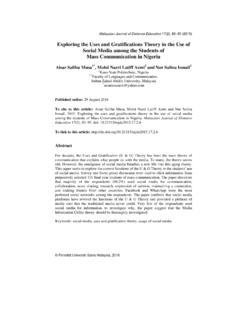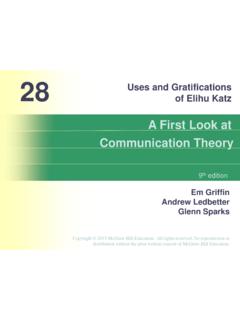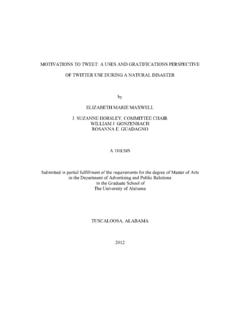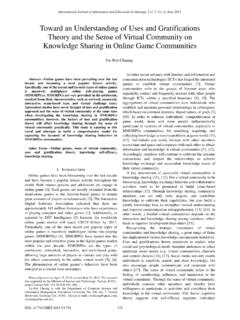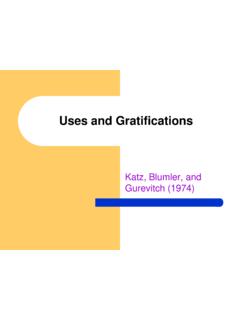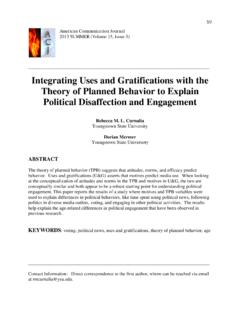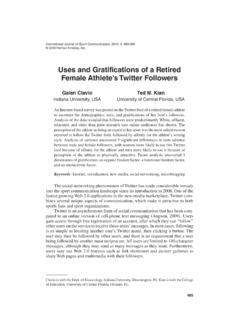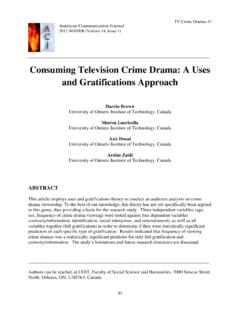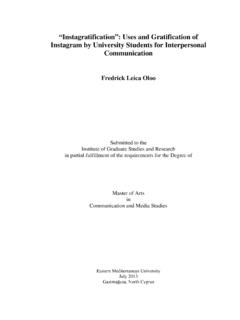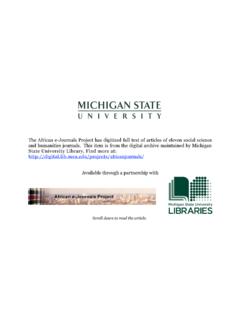Transcription of A Critical Analysis Of The Uses and Gratifications ...
1 A Critical Analysis Of The uses andGratifications experienced By SouthAfrican Users Of The Digital DoorwayFaizah Jummai AbbasMonash south AfricaAbraham Gert van der VyverMonash south Alphonso MaraisThe Meraka InstituteSouth The Digital Doorway is a computerized machine that was implemented in areas populated by disadvantaged communities throughout south Africa to promote computer literacy within these communities. Understanding the progress and satisfaction of users of the digital doorway is highly significant in capturing important facts that can be used to further improve the system in the study will provide a qualitative perspective regarding the use of the machine as well as the Gratifications experienced by the users from their acquired computer access and knowledge.
2 The researchers conducted content Analysis of a sample of 100 narratives in order to identify the uses and Gratifications experienced by the users. The collected data was obtained from a narrative inquiry that was conducted by a research team of the Meraka Institute. The third author is a member of that team. The findings of the study extended the knowledge base regarding the users perspective of the machine. The project enabled the researchers to contribute to the achievement of the initial goal of the Digital Doorway namely to improve computer literacy in impoverished doorway, unsupervised learning, qualitative Analysis , narratives, uses , Gratifications , domains, coursesIntroductionThe digital doorway is a unique south african computer artifact designed to bridge the digi-tal divide between advantaged and disadvantaged communities.
3 Gush (2011:16) com-mented that (t)he Digital Doorway (DD) is a standalone rugged multi-terminal computer Steyn, J., Van der Vyver, (eds.). (2013). Public and private access to ICTs in developing regions. Proceedings of the 7th International Development Informatics Association Conference, held in Bangkok, Thailand. ISBN: 978-0-620-58040-3 Pages 186-205185system that is placed at various strategic sites in impoverished areas of south Africa. Mul-tiple DD sites over 200 are currently in operation as of 2011. Since it is now more than a decade since the first DD was operationally implemented and the researchers had ac-cess to a large dataset of narratives that were collected form users of the DDs, they en-gaged in a content Analysis project of these narratives.
4 This paper is one of the outcomes that resulted from this ongoing paper starts with explanations of the digital divide, and unsupervised learning. This is followed by a short history of the development of the DD concept. The last section of the literature review is dedicated to the uses and Gratifications theory that was used to anchor the empirical part of the methodology followed by the researchers is subsequently explained after which they explicate their Analysis and the ReviewThe digital divideThe concept of the digital doorway has been developed in order to overcome the digital divide.
5 The term digital divide has been defined by many authors. A selection of definitions has been embedded in Table 1: AUTHOR / AUTHORS DEFINITION(KEEBLE, 2003) THE TERM DIGITAL DIVIDE MAY BE TAKEN AT THEBROADEST LEVEL TO REFER TO THE GAP BETWEENTHOSE INDIVIDUALS AND COMMUNITIES WHO OWN,ACCESS, AND EFFECTIVELY USE ICTS AND THOSEWHO DO NOT (BROWN, CAMPBELL & LING, 2011) ..THE DIGITAL GAP BETWEEN THOSE WITHACCESS TO KEY COMMUNICATIONS TECHNOLOGIESAND THOSE WITHOUT ACCESS. (FUCHS & HORAK, 2008). THE TOPIC OF THE DIGITAL DIVIDE CONCERNS THEUNEQUAL ACCESS TO AND USAGE OF NEWTECHNOLOGIES.
6 (GURSTEIN 2003) ..DESCRIBES THE FACT THAT THE WORLD CAN BEDIVIDED INTO PEOPLE WHO DO AND PEOPLE WHODON T HAVE ACCESS TO AND THE CAPABILITY TOUSE MODERN INFORMATION TECHNOLOGY, SUCHAS TELEPHONE, TELEVISION, OR THE INTERNET .Although Brown et al. (2011) describe the digital divide only in terms of accessibility, all theother cited definitions also make mention of the ability to use these technologies. Theauthors of this paper concur with the majority , J., Van der Vyver, (eds.). (2013). Public and private access to ICTs in developing regions. Proceedings of the 7th International Development Informatics Association Conference, held in Bangkok, Thailand.
7 ISBN: 978-0-620-58040-3 Pages 186-205186 The impact of the digital divide in different societies is considered to be of major phenomenon that certain segments of a community fall behind in terms of technologyand/or common literacy and knowledge creates a split economy with a vast number ofindividuals missing out on the benefits that knowledge alone can offer. Despite the rapidgrowth of the use of technologies among all communities, the impact on the general well-being of societies is not only positive. These digitized societies, more often than not, sufferfrom fragmented labour forces and bridging of the digital divide is essential to prevent a sub-divided economy thatseparates the haves from the have-nots.
8 Furthermore, it is essential to provideopportunities for those who lack the means or the capacity of accessing thesetechnologies (Keeble, 2003). Macleod (2005) underscored the following statement made by Kofi Annan during histenure as Secretary-General of the United Nations: A wide consensus has emerged aboutthe potential of information and communications technologies (ICT) to promote economicgrowth, combat poverty, and facilitate the integration of developing countries into theglobal economy. Seizing the opportunities of the digital revolution is one of the mostpressing challenges we face Mitra & Dangwal (2010) consider the divide to affect individuals in learning societies thatreside in impoverished areas.
9 The authors state that the lack of well-establishededucational institutions affect children in these areas as they are denied the right toeducation. By bridging the gaps these gaps the disadvantaged societies can graduallybecome part of the technologically advanced role of the DDs in these disadvantaged learning societies features prominently in thefollowing learning The concept of the DD is based on the principle of unsupervised learning. The ideas andconcepts behind the Digital Doorway were triggered by the ideas of Dr. Sugata Mitra of theNational Institute of Information Technologies (NIIT) in India.
10 Mitra, (2003) brought about the notion of the Hole in the Wall (HiTW) which involved anovel idea to implement computer systems throughout impoverished areas in India inorder to raise the level of computer literacy. The founder of the project considered acomputer literate child as one who is able to switch on a computer, browse through webpages, send and receive email messages and use drawing tools (Mitra, 2000). Accordingto Mitra, (2003), the project was initiated in order to investigate: The extent to which individuals have the ability to explore and learn for themselveson their own.
